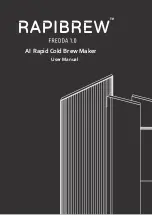
19
Side Panel Description and Explanation:
1.
Wire Spool Carrier Assembly.
Make note of
the correct assembly order if disassembled.
The order in which they are assembled is im-
portant to be able to provide enough re-
sistance to prevent de-spooling of the wire.
When inserting the spool , make sure the small
tab on the inside of the spool holder is located
in one of the recesses made into the spool, if
any. Tighten the hex head screw under the
hand nut after installing the wire spool so that
the wire will not continue to keep rolling more
than a 1/4 turn after wire has stopped feeding.
Do not over tighten so that the drive roller
slips or the feeder strains to pull the wire due
to excessive resistance. The tensioner assem-
bly can accommodate
8”
spools of wire (10
-
12 lbs.) However, a simple center adapter may
be easily fabricated from PVC pipe to accom-
modate the smaller
4”
diameter roll (2lb roll).
NOTE:
4”
rolls may cause excessive cast due
to the tighter coiling of the wire around a
smaller center hub. These can cause issues
with the wire corkscrewing while welding and
interfere with arc stability as the wire wanders
from side to side. It also can create feeding
issues as it can be more difficult to thread
through the drive roller causing the wire to
jump outside the groove if proper pressure is
not maintained.
2.
Polarity Buss Bar.
Note the
“+”
and
“-”
sym-
bols located on the inside of the unit next to
the buss bar terminals. To change the polarity
of the MIG torch, simply loosen the middle
screw and remove the other screws on the
polarity terminals. By pivoting the buss bar on
the center loosened screw, swing the buss bar
into position over the desired polarity. Rein-
stall the screws, lining up the holes in the buss
bar with the terminal. Tighten all buss bar
screws. Always remember to alter your work
clamp to reflect the polarity change if using
flux core. If the buss bar is connected to nega-
tive, then the work clamp should be in the
“+”
positive output terminal.
Standard polarity for
MIG is
“+”
(DCEP) with the work clamp in the
negative.
3. Burn Back Timer Control.
The burn
-
back con-
trol helps to prevent too much stick out when
restarting a weld, by keeping the arc energized
for a short time after the wire feeder stops
feeding . The wire will burn back to the de-
sired length by adjusting the control. This im-
proves re
-
starts and keeps the user from hav-
ing to re
-
trim the wire between welds.
NOTE:
Too much burn back time may cause the wire
to burn back to far and seize to the tip.
4.
Wire Feed Assembly.
Note the numbers on
the side of the tensioner. These numbers are a
reference point to help properly tension the
wire so that the drive roller will not slip. Do
not over
-
tension the wire because it can create
a condition known as birds nesting, where the
wire will tangle up around the feeder and will
not slip if the wire burns back into tip, sticks
fast in the weld puddle or other resistance is
met. This will continue wrap the wire around
the drive mechanism or jam wire inside the
gun liner until the trigger is released. Consid-
erable effort is usually needed to clear out a
bird
’
s nest condition. Too little tension will
result in wire slippage and cause rapid wear on
the drive components. Do a feed test before
beginning a weld. Occasional cleaning of the
feeder mechanism is necessary to prevent
wear and damage to the feeder and to the
MIG gun liner. Regularly monitor any metal
flaking and dirt build up that may occur. Clean
it away gently with compressed air. Do not use
harsh cleaners or solvents. Felt wire lubricators
may be bought and used to keep feeding
cleanly while using steel or stainless wire.
You
may purchase additional drive roll sizes from
Everlast, including flux core. Each groove will
drive at least two sizes of wire. For example if
the roller has a .8 mm groove and a 1.0 mm
groove, this will allow either
.030”
and
.035”
wire to be used in the smaller groove. The
larger groove allows
.040”
and
.045”
wire to be
used. Do not forget to change the contact tip
size when changing to a another wire diame-
ter. Depending upon the size wire used, the
liner from the MIG gun may need to be
changed to work properly. Do not attempt to
feed any wire greater than
.045”
wire with the
welder. Most common jobs can be welded
with either
.030”
or .
035”
wire.
Setup Guide and component Identification
Section 2
NOTE:
If erratic feeding is experienced, check
wire feed tensioner, Spool Tension (rolling
resistance) and for correct size groove. Also
make sure the wire is riding in the groove and
not on the shoulder of the lower drive roll.














































